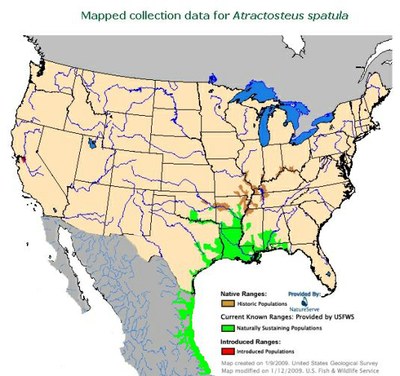Alligator Gar (Atractosteus Spatula)

Watershed Distribution Status of Alligator Gar

KEY
Green - Naturally Sustaining Populations
Orange - Remnant Populations or Individual Observations
Red - Stocked Population
Yellow - Approximate Historic Range (Possibly Extirpated)
Atractosteus spatula - (Lacepède, 1803)
Alligator Gar
Syn: Lepisosteus spatula (Formerly genus Lepisosteus)
Taxonomy: Animalia, Chordata, Vertebrata, Osteichthyes, Actinopterygii, Neopterygii, Semionotiformes, Lepisosteidae, Atractosteus
Alligator Gar are often confused with other more commonly encountered gar species due to their similarity of appearance to the untrained eye. Most people capturing the more common species believe they have caught an alligator gar and will refer to it as so. However, this species is easily distinguishable with experience, training, and upon visual comparison.
Alligator gar are distinct from other gars by having a heavier and broader body, a short broad snout, and numerous large teeth. Teeth are large and canine like in size, however, while most of their teeth are needle sharp at the tip some fish have less sharp pre-molar-like teeth, possible due to heavy use and age. The number, rows, and locations of the teeth are highly variable with some fish having teeth in and outside of the closed mouth in what appear like revolving rows for replacement of lost teeth. When the mouth is closed they teeth seat into recessed openings on the corresponding jaw. Alligator gar and other members of Atractosteus have two rows of teeth on the upper jaw. The second row of teeth is located inside the mouth, not to be confused with the externally visible teeth that can be seen when the mouth is closed. Some shortnose gar have also been observed with double rows of teeth on the upper jaw leading to inaccurate identification; however, other morphological differences are distinguishable when examined more closely.
Their coloration is generally dark olive green dorsally fading to gray-white sides and white ventrally. The large ganoid scales are dotted mid-dorsally with varying camouflaging shades mixing between black and light colored golden-white spots. Dorsal, caudal, and anal fins have black spots and are mostly olive green or gray while pelvic and pectoral fins are generally unspotted and gray-white to white. Gill plates vary in color from bronze-olive, gray, and silvery white. Fins, particularly ventrally, along with ventral scales often have a reddish-pink hue or lines most likely associated with blood vessel saturation. All colors tend to fade grayer and whiter with increased turbidity. Specimens from clearer water tend to be darker and have more patterns dorsally.
Larval to juveniles have a light colored (lustrous in
sunlight) stripe or spots linearly along the dorsal line which fade with growth through the first few weeks of life resulting in a solid dark green or olive dorsal appearance. Within the first few months they have black and dark green spots, bands, and/or blotches laterally and their are bodies are more olive-bronze or golden colored dorsally with silvery white gill plates and lower jaw. Fins are similar in color and patterns as adults.
Life History and Ecology
 This species is most commonly found in slower moving rivers, oxbows, reservoirs, and brackish estuaries along the Gulf of Mexico, but they have also been occasionally found further out in salt water. They have been found to congregate in high densities and close proximities at certain locations for pre-spawn staging (typically April-May), spawning (typically April-June), and over wintering (December-February); however the spawning period may vary widely base on environmental conditions and location. Post spawn observations and data suggest solitary or territorial behavior post-spawn and through the fall months. However, there have been reports and documented observations of congregations during the post-spawn period. In addition, there are unconfirmed reports of fishermen observing fall spawning fish in October in years with high water.
This species is most commonly found in slower moving rivers, oxbows, reservoirs, and brackish estuaries along the Gulf of Mexico, but they have also been occasionally found further out in salt water. They have been found to congregate in high densities and close proximities at certain locations for pre-spawn staging (typically April-May), spawning (typically April-June), and over wintering (December-February); however the spawning period may vary widely base on environmental conditions and location. Post spawn observations and data suggest solitary or territorial behavior post-spawn and through the fall months. However, there have been reports and documented observations of congregations during the post-spawn period. In addition, there are unconfirmed reports of fishermen observing fall spawning fish in October in years with high water.

Eggs and yolk sacs have been found to be extremely toxic to crustaceans and vertebrates other than teleost fishes, presumably as a defense mechanism. Crayfish and blue crabs in particular are susceptible to the toxin. Humans are also susceptible and should not eat or even handle the eggs without taking proper precautions.
 Growth rates of young-of-year fish are extremely fast and it is not uncommon for a fish to attain 10-12 inches in size within the first year after hatch. Juveniles are often trapped behind dams, weirs, levees, or other natural obstructions as spring waters recede often resulting in complete utilization of food resources and subsequent cannibalism.
Growth rates of young-of-year fish are extremely fast and it is not uncommon for a fish to attain 10-12 inches in size within the first year after hatch. Juveniles are often trapped behind dams, weirs, levees, or other natural obstructions as spring waters recede often resulting in complete utilization of food resources and subsequent cannibalism.
There currently is no information on juvenile life history from age 1 up to adult fish (reproductively viable or ~ 45 lbs.). These fish are presumed to be in such low numbers and spread out over such vast distances and habitat that they are rarely encountered. It is unknown whether or not they are migratory.
Adult fish feed primarily on fish, but have been found to also consume blue crabs, birds, reptiles, amphibians, and small mammals. They are believed to forage primarily at night, but have been seen both day and night lying motionless against floating logs, debris, or under overhanging trees. Similar to other gar species they are frequently observed surfacing for air. The reason for this is uncertain. It has been suggested that this is a form of obligate breathing to supplement low dissolved oxygen (DO) conditions; however, observations during high DO periods suggest otherwise or that there might possibly be multiple purposes for this behavior. They are commonly heard and seen blowing bubbles and making gulping sounds in concert with other alligator gar suggesting possible communication. Possibly to warn the others of a threat or to assert its territory.
Distribution, Abundance, and History
In addition to their range decline their numbers have also substantially decreased over the past 50 years. Alligator gar were once abundant in many watersheds where they are now difficult to find. There are many reasons being considered for their decline including habitat loss resulting from navigation and flood control alteration of streams and flood plains to over harvesting. They were considered in some places a highly sought after sport and commercial fish, but mostly they were considered a "trash fish" and were targeted for eradication or control. Historical pictures, accounts, and fishermen all support the substantial decline of the species.
 Today they are rarely encountered throughout most of their historic range; however, they are still abundant, despite declining numbers, in Louisiana and Texas where there is a significant sport fish and commercial food fish market. Bowfising accounts for most of the take by sport fishing with some hook and lining. Numerous guides are available for hire as well as "how to" videos. Jug lining is the typical method used for commercial harvest in Louisiana, Texas, and Alabama although unreported net by-catch may have been and may continue to be substantial throughout its range. Many states where they were once unregulated now have or are considering regulations for management, conservation, and recovery of the species. Some propagation and stocking has occurred with fish being produced by the U.S. Fish & Wildlife Service's Private John Allen National Fish Hatchery for stocking in Missouri, Tennessee, Arkansas, and Mississippi.
Today they are rarely encountered throughout most of their historic range; however, they are still abundant, despite declining numbers, in Louisiana and Texas where there is a significant sport fish and commercial food fish market. Bowfising accounts for most of the take by sport fishing with some hook and lining. Numerous guides are available for hire as well as "how to" videos. Jug lining is the typical method used for commercial harvest in Louisiana, Texas, and Alabama although unreported net by-catch may have been and may continue to be substantial throughout its range. Many states where they were once unregulated now have or are considering regulations for management, conservation, and recovery of the species. Some propagation and stocking has occurred with fish being produced by the U.S. Fish & Wildlife Service's Private John Allen National Fish Hatchery for stocking in Missouri, Tennessee, Arkansas, and Mississippi.
There is also a non-native commercial and sport fishery being developed outside of its natural range in Central America and Thailand. Much of the work being done to better understand the biology of this species and to develop it for aquiculture is occurring in Mexico where it is know as catan and is highly sought after along with other gar as a food fish by gill netters and sold at local markets. Thailand sport fishing enthusiasts and guides advertise the sport worldwide. They have also been introduced and have established populations in isolated locations in California and Nicaragua.
No
No
No
No
http://www.sdafs.org/alligar/index.html
Document Actions






